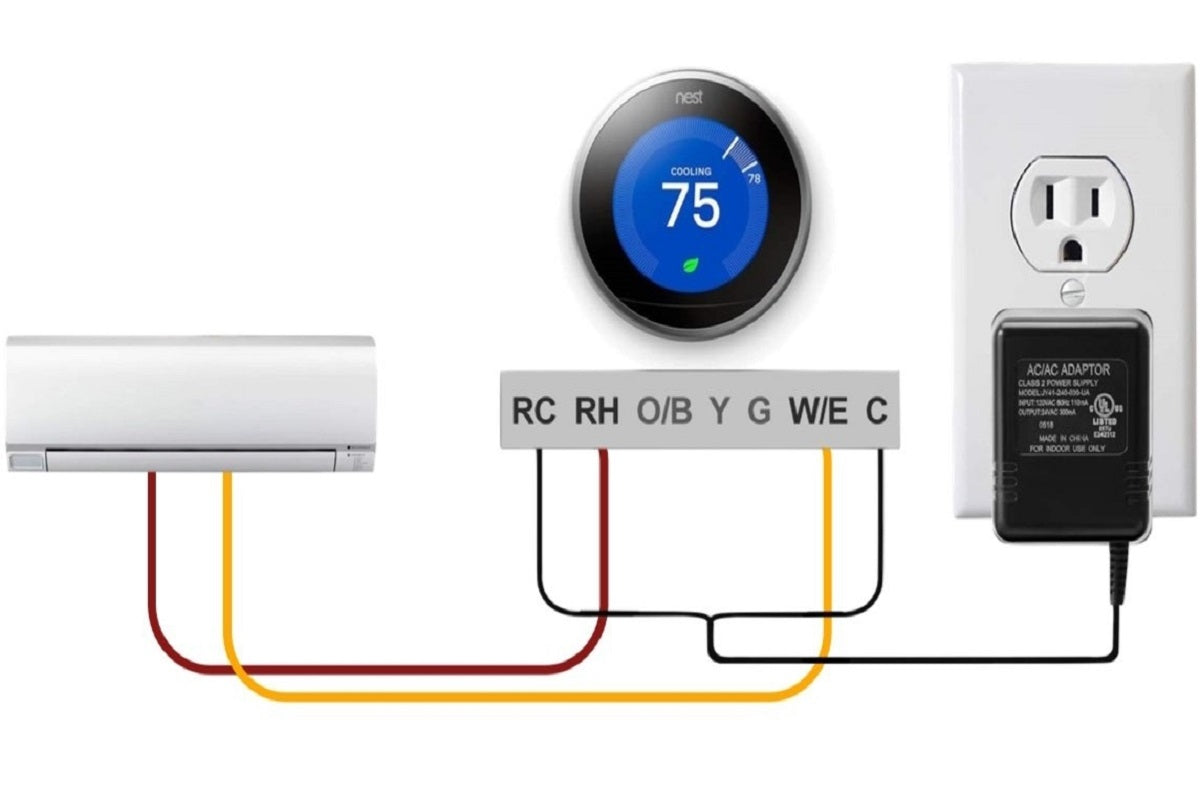Introduction
Smart thermostats are revolutionizing the way you manage home comfort, offering both energy savings and convenience. Many homeowners are curious about how to install a smart thermostat without a C wire. While a C wire provides continuous power, not every home is equipped with one. Fortunately, installing a smart thermostat without a C wire is feasible. You can utilize adapters or rechargeable batteries to power these devices. Smart thermostats are effective in reducing energy costs, which is why approximately 20% of U.S. adults plan to adopt them for this purpose. The market for smart thermostats is expanding rapidly, with projections indicating significant growth in the coming years.
Ⅰ Understanding the Basics
1.1 What is a Smart Thermostat?
Smart thermostats are like your home's personal assistant for heating and cooling. These nifty devices let you control the temperature with ease and even learn your habits to keep you comfy. Imagine adjusting your home's temperature from your phone or having the thermostat tweak settings based on your daily routine. That's the magic of smart thermostats!
1.2 Features and Benefits
Smart thermostats come loaded with features that make life easier. You get programmable settings, which can cut down those pesky energy bills. The sleek design and LED screens add a modern touch to your home. Wi-Fi connectivity means you can manage everything from your smartphone. Plus, some models even integrate with voice assistants like Alexa or Google Assistant.
Programmable settings for energy savings
LED screens for a modern look
Wi-Fi connectivity for remote control
Voice control integration with smart home systems
Compatibility with HVAC Systems
Not all smart thermostats play nice with every HVAC system. It's crucial to check if your system is compatible before diving in. Some thermostats work with most systems, while others might need a bit of tweaking. Always double-check the compatibility to avoid any hiccups during installation.
Ⅱ The Role of a C Wire
The C wire, or common wire, is like the unsung hero of thermostat installations. It provides continuous power to your smart thermostat, ensuring everything runs smoothly. But what happens when your home doesn't have one?
2.1 Why Some Thermostats Require a C Wire
Some thermostats need a C wire to function properly. This wire keeps the thermostat powered without relying on batteries. Without it, you might face issues like frequent battery changes or connectivity problems.
2.2 Alternatives to Using a C Wire
No C wire? No problem! You have options. Use a power extender kit or an adapter to bypass the need for a C wire. Some smart thermostats even come with rechargeable batteries, eliminating the need for constant power. You could also repurpose an existing wire to act as a C wire. Always explore these alternatives to find the best fit for your setup.
Power extender kits for easy installation
Adapters to replace the C wire
Rechargeable batteries for uninterrupted power
Repurposing existing wires for a quick fix
Setting up a smart thermostat without a C wire is totally doable. With a little know-how and the right tools, you'll be on your way to a smarter, more efficient home.
Ⅲ Tools and Materials Needed

Getting ready to install a smart thermostat without a C wire? You need the right tools and materials. Let's dive into what you'll need to make the process smooth and hassle-free.
3.1 Essential Tools
Screwdriver
A trusty screwdriver is your best friend for this task. You'll use it to remove the old thermostat and secure the new one in place. Make sure you have both a flat edge and a #2 Phillips screwdriver on hand. These will cover most of the screws you'll encounter.
Wire Stripper
A wire stripper is essential for prepping the wires. You need clean, exposed ends to make solid connections. This tool helps you strip away the insulation without damaging the wire itself. A good wire stripper makes the job easier and ensures a safe installation.
3.2 Additional Materials
Power Extender Kit
A power extender kit can be a lifesaver if you're missing that C wire. It provides the necessary power to your thermostat without needing to rewire your entire system. Many kits come with detailed instructions, making them user-friendly even for beginners.
Adapter Options
Adapters offer another great solution for powering your smart thermostat. Some thermostats come with adapters that convert existing wires to provide continuous power. Check your thermostat's manual to see if an adapter is included or recommended.
With these tools and materials, you're all set to tackle the installation. Remember, preparation is key to a successful setup. Happy installing!
Ⅳ Step-by-Step Installation Guide

Ready to dive into the installation process? Let's walk through how to install a smart thermostat without a C wire step by step. You'll find it easier than you might think!
4.1 Preparing Your Thermostat
Turn Off Power
Safety first! Always turn off the power to your HVAC system before starting any installation. Head over to your circuit breaker and flip the switch for your heating and cooling system. This step prevents any accidental shocks or damage to your equipment. A smart thermostat without a C wire needs a safe environment for installation.
Remove Old Thermostat
Now, it's time to say goodbye to the old thermostat. Carefully remove the faceplate to reveal the wiring. Take a picture of the current wire setup for reference. This photo will help when connecting the new smart thermostat without a C wire. Unscrew the baseplate and gently pull the wires through. Keep those wires handy for the next steps.
4.2 Wiring the Thermostat
Identifying Wires
Identifying wires is crucial. Look at the picture you took earlier. Each wire should have a label. Common labels include R (power), W (heat), Y (cooling), and G (fan). Some setups might have extra wires. A smart thermostat without a C wire may need an adapter or power extender kit. These tools help provide continuous power.
Connecting Without a C Wire
Connecting without a C wire involves using alternative methods. Many smart thermostats come with adapters. These adapters convert existing wires to supply power. Follow the manufacturer's instructions for connecting the adapter. If your thermostat supports battery operation, insert the batteries now. A smart thermostat without a C wire can function smoothly with these options.
4.3 Configuring the Thermostat
Setting Up Wi-Fi
Once the wiring is complete, attach the new thermostat to the wall. Power on your HVAC system. The thermostat should light up. Follow the on-screen prompts to connect to your Wi-Fi network. A smart thermostat without a C wire often relies on Wi-Fi for remote control. Ensure a strong connection for optimal performance.
Customizing Settings
Finally, customize the settings to suit your preferences. Set your desired temperature range and schedule. Explore features like geofencing or voice control if available. A smart thermostat without a C wire offers many of the same conveniences as those with a C wire. Enjoy the energy savings and comfort adjustments at your fingertips.
Congratulations! You've successfully installed a smart thermostat without a C wire. This setup enhances your home's efficiency and comfort.
Ⅴ Troubleshooting and Tips
5.1 Common Issues
Power Problems
Smart thermostats sometimes face power hiccups. A thermostat might not turn on or stay on. Check the wiring connections first. Loose wires often cause power issues. Ensure each wire is snugly connected to the correct terminal. If the thermostat uses batteries, check those too. Fresh batteries can solve many problems.
A power extender kit or adapter could also be the culprit. Verify the installation of these components. Follow the manufacturer's instructions closely. Incorrect setup leads to power interruptions. If problems persist, consider consulting a professional.
Connectivity Issues
Connectivity issues frustrate many smart thermostat users. Wi-Fi connection problems top the list. Ensure the router is working properly. A strong signal is crucial for thermostat performance. Move the router closer if needed.
Check the thermostat's settings next. Ensure the correct network and password are selected. Restarting the router and thermostat often resolves connectivity woes. If issues continue, consult the thermostat's manual. Some models offer specific troubleshooting steps for connectivity.
5.2 Professional Advice
When to Call a Professional
Sometimes DIY fixes fall short. Knowing when to call a professional saves time and stress. Complex wiring issues require expert intervention. HVAC professionals possess the skills to diagnose and fix intricate problems.
"Beyond basic troubleshooting you can do yourself, nothing beats expert help," says an HVAC professional. "An HVAC professional can quickly and accurately diagnose the problems you’re having with your system."
Professional services come with a cost. Consider this when deciding to seek help. Weigh the benefits of expert assistance against potential expenses.
Safety Considerations
Safety should always be a priority. Working with electrical components poses risks. Always turn off power before handling wires. Use insulated tools to prevent shocks. Avoid touching exposed wires with bare hands.
If unsure about any step, pause and reassess. Safety concerns warrant professional help. Experts ensure safe and proper installation. Prioritize safety over speed to protect yourself and your home.
Ⅵ Conclusion
You've now mastered how to install a smart thermostat without a C wire. Enjoy the comfort and energy savings that come with this modern upgrade. Smart thermostats offer features like remote access and programmable schedules. These features enhance your home's efficiency. Remember to check compatibility and follow safety precautions during installation. A recent survey revealed that 20% of U.S. adults plan to adopt smart thermostats for energy cost reduction. Join this growing trend and experience the benefits firsthand. Keep an eye on your energy bills and watch them shrink as your home becomes smarter.

